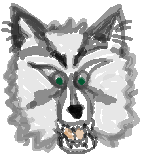(Wolverines)


Wolverines are one of the largest members of the weasel family. Adult males weigh between 15 to 25 kilograms and are about 1 metre from snout to tail. Females are just a little smaller. Wolverines have a bushy tail, a long and thick brown coat, light fur along the back (from shoulder to tail) and cream coloured fur along the chest and throat.
The wolverine's habitat includes the Yukon and the Northwest Territories. They also live in the north of all other Canadian provinces (except the maritimes) and the west coast of Canada and U.S.A. Due to their scavengous characteristics, wolverines do not stay in one place for very long and keep moving for days at a time.
The wolverine eats carrion (dead animals) most of the time but won't miss an opportunity when it presents itself. They have a reputation of a glutton and because of that characteristic, a wolverine will eat anything from wasps to whales. The wolverine hunts not by stealth or surprise, but by the direct chase. They are not particularily fast animals but have incredible endurance. On a long stretch they have no chance, but, in snow, with their wide spread toes and powerful jaws, they can easily overpower most animals. They have a different strategy to take down deer, caribou and other such hooved animals. They hide up in trees and when a deer, passes under them, they jump off the tree and on to the victim's back. They bite either their spine or jugular vein. Under the right circumstances a wolverine could take down a bull moose.
However, the Furry Fury Wolverine is an endangered animal. There is not really one specific reason why the wolverine is endangered. One reason is, of course, man. Trappers have already made a very rare animal even more rare. Another reason is the declining wolf population. Although wolves are the only thing that eat wolverines, the majority of the carrion that wolverines eat are wolf kills. The major reason we think that wolverines are endangered is that they are very rare animals by themselves. Even without man interfering, they would still be very rare.
By: Andrew Boyes and Kevin Ziegler
We got our information from:
World Encyclopidia 1988 and Wild Mammals of Western Canada, by: Candace and Arthor Savage.